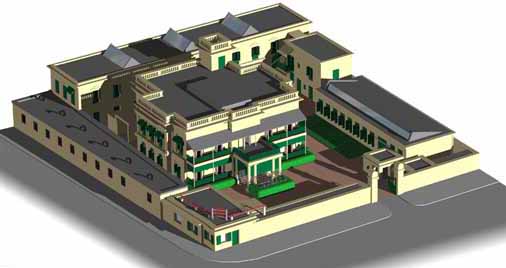
The Images 1. Map of Calcutta showing Baptist Mission Press in relation to other places of interest.
2. A Three-Dimensional Drawing of the Baptist Mission Compound.
3. A Three-Dimensional Drawing of Baptist Mission Press. | Small | Large
4. A Three-Dimensional Drawing of the Press only showing relevant Departments. | Small | Large
5. A mid 19th century Map of Calcutta showing Baptist Mission Press.
Black and white photographs of the Press taken by Bernard Ellis in the early 1950's 6. Exterior of the Press from Lower Circular Road showing the Book Room and Elliott Road.
7. Exterior of the Press from Lower Circular Road.
8. Exterior of the Press from ground level.
9. Norman Ellis, Superintendent 1932-1960, in his office.
10. Bernard Ellis, when Assistant Superintendent (1947-1960). Superintendent 1960-1966) with senior members of the office staff.
11. Group photograph of all Baptist Mission Press staff on Bernard Ellis's retirement in 1966.
12. Senior Baptist Mission Press staff get together on a day off.
13. The Composing Room where text was skillfully composed by hand in the time honoured fashion. After printing the forms were broken down, the type cleaned, and replaced in the cases.
14. The delivery of paper from Titaghur Paper Mills. Titaghur is on the opposite bank of the Hooghly to Serampore, and is just south of Barrackpore.
15. Linotype Department. Copy was keyed in by hand. Moulds (called matrixes) fell down from the top of the machine and lined up in the correct order. Wedge shaped word spaces were then inserted to fill out the line of type. The whole line was then cast as a slug (hence Linotype) and the matrixes returned to the top of the machine to be re-used. After printing the slugs were melted down and the metal re-used. Before computers this is how all newspapers were set.
16. Monotype setters key copy into the machine, which punches coded holes onto a paper tape.
17. The paper tape was fed into a Monotype Setter and each character was cast individually from molten metal (hence Monotype). Usually used for book production as it provided the best quality print. After printing the type was melted down and the metal re-used.
18. Exterior of the Machine Room.
19. Interior of the Machine Room where the printing was done. The picture shows cylinder presses, but there were also platen machines for small print runs which were fed by hand.
20. A new automatic Heidelberg letterpress platen machine.
21. The Binding Department where pages were collated, stitched and bound into books.
22. Moving machinery.
23. The Confidential Department where examination papers for universities all over India were produced. Suresh, the manager, is on the right.
24. A new cylinder letterpress machine is installed in the Confidential Department.
25. The Book Shop with the manager seated right.
26. Some satisfied European customers.
27. Some satisfied customers from Bhutan.
28. Loading up for delivery to the customer.
29. Bernard Ellis, Freda Ellis, and family. Assistant Superintendent 1946-1961, Superintendent 1961-1966.
30. Norman and Peggie Ellis. Assistant Superintendent 1931-1941, Superintendent 1945-1961.
31. Rev. and Mrs. Percy Knight. Superintendent 1925-1941.
Return to Miscellaneous